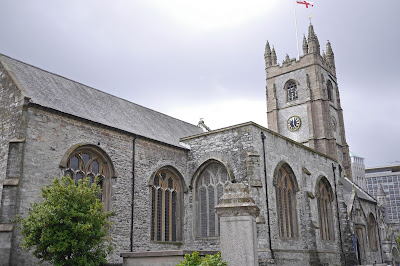The Tudor House
We had planned to continue the Coast Path around Plymouth, but the forecast was so bad, including severe weather warnings, that we ended up making a late decision to do a city walk around Plymouth instead. One or two of the photos were obviously not taken today!
We started at the Barbican and where the Coast Path goes left, we turned right along the side of Sutton Harbour and immediately detoured left in New St to see the Tudor House and the similar Elizabethan House opposite it in this narrow lane. Both have jettied-out upper storeys.
We turned into Southside St and walked to the end to see the impressive Plymouth Gin Distillery, with its curving facade. It dates from 1793 and incorporates parts of the Blackfriars convent of 1383 - the old door can be seen to the left of the arched entrance to the distillery.
At the end we headed towards the newer part of Plymouth and stumbled on the so-called Merchant's House (Pevsner refers to it more prosaically as 33 St Andrew St). Unusually, it has stone side walls and a timber-framed front. The amount of window is very impressive. It too is Tudor.
Nearby, and not mentioned on the Plymouth Walks website, is the Prysten House, which Pevsner tells us dates from the late 15th century and was built by Plympton Prior. It is a fine sight, with a distinctly medieval appearance.
We now walked up to the huge St Andrew's church - the largest parish church in Devon - dating from 1430-90. It was restored in Victorian times and again after bomb damage during the war.
Immediately next door is the Guildhall complex including the Assize Courts and former city Treasury. We approached from the restored end - again after wartime bombing. What you see is late Victorian in a French Gothic style, with tourelles on the corners. Apparently the building was saved from demolition by a single vote of the Council in 1951.
At the end is the modern entrance, a curious combination of a squat octagonal tower and what looks more like an Italian campanile than anything else. This new part was opened in 1959, at the same time as the renovation concluded.
Opposite this group is the rebuilt town centre, a dispiriting collection of rather ugly concrete buildings. The whole of the centre was destroyed in the "Plymouth blitz" on 21 and 22 March 1941. I gather than for students of town planning Plymouth is a significant historical case study as it was, uniquely, constructed according to a single plan, the work of Sir Patrick Abercrombie. Kevin McCloud has hailed it as "beautiful and heroic" and is campaigning with English heritage to get it listed (Daily Telegraph 8 June 2011). However, even the City Council have apparently resisted previous efforts at listing. The one obvious good thing is that the centre is spacious, with wide pedestrianised spaces and thoroughfares.
We walked down the hill to see one last impact of the blitz. The Charles Church is seemingly so called because the residents had to petition Charles I to allow the existing single parish of St Andrews to be partitioned into two and a new church to be built. Construction started in 1640, but was suspended during the Civil War siege of Plymouth (1642-6) and not completed until 1658. The spire was was erected in 1767, replacing the original wooden one covered with lead. His chief historical interest is that "in spite of its date it is wholly gothic in character and largely in detail" (Pevsner).
The church was gutted in the blitz and was left derelict until 1957. At that point it was acquired by the City council who carried out preservation works. It is now a memorial to the civilians of Plymouth who died as a result of air raids during the war. It is an extremely powerful and poignant reminder.
From here we meandered back to the Quayside where we admired the proportions of the Custom House of 1810 ...
... and the pleasing collection of old buildings on the other side leading down to the Barbican.
Conditions: mild, but mainly grey and with a threat of rain
Distance: about 3 miles.
Rating: three and a half stars.










No comments:
Post a Comment